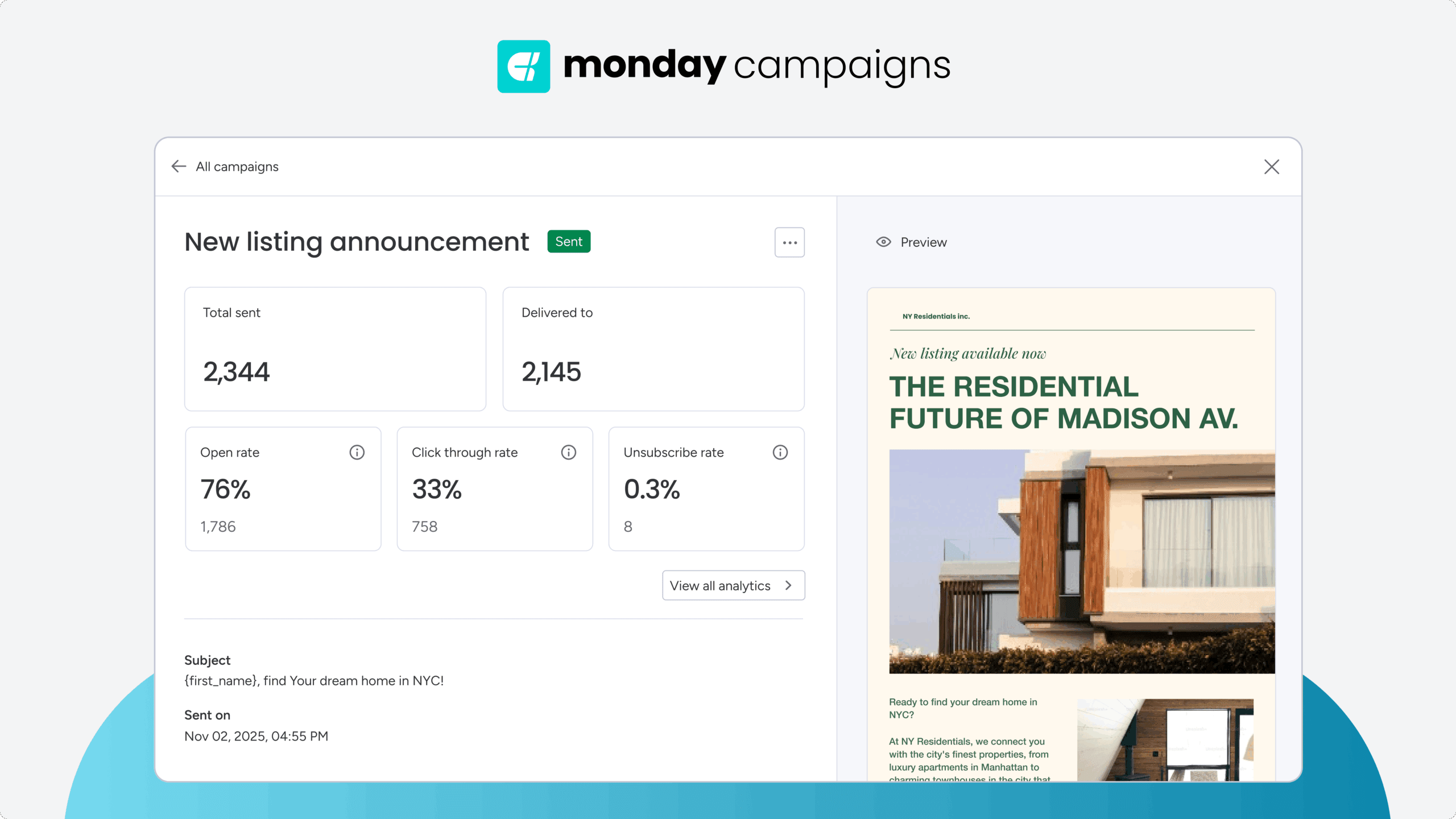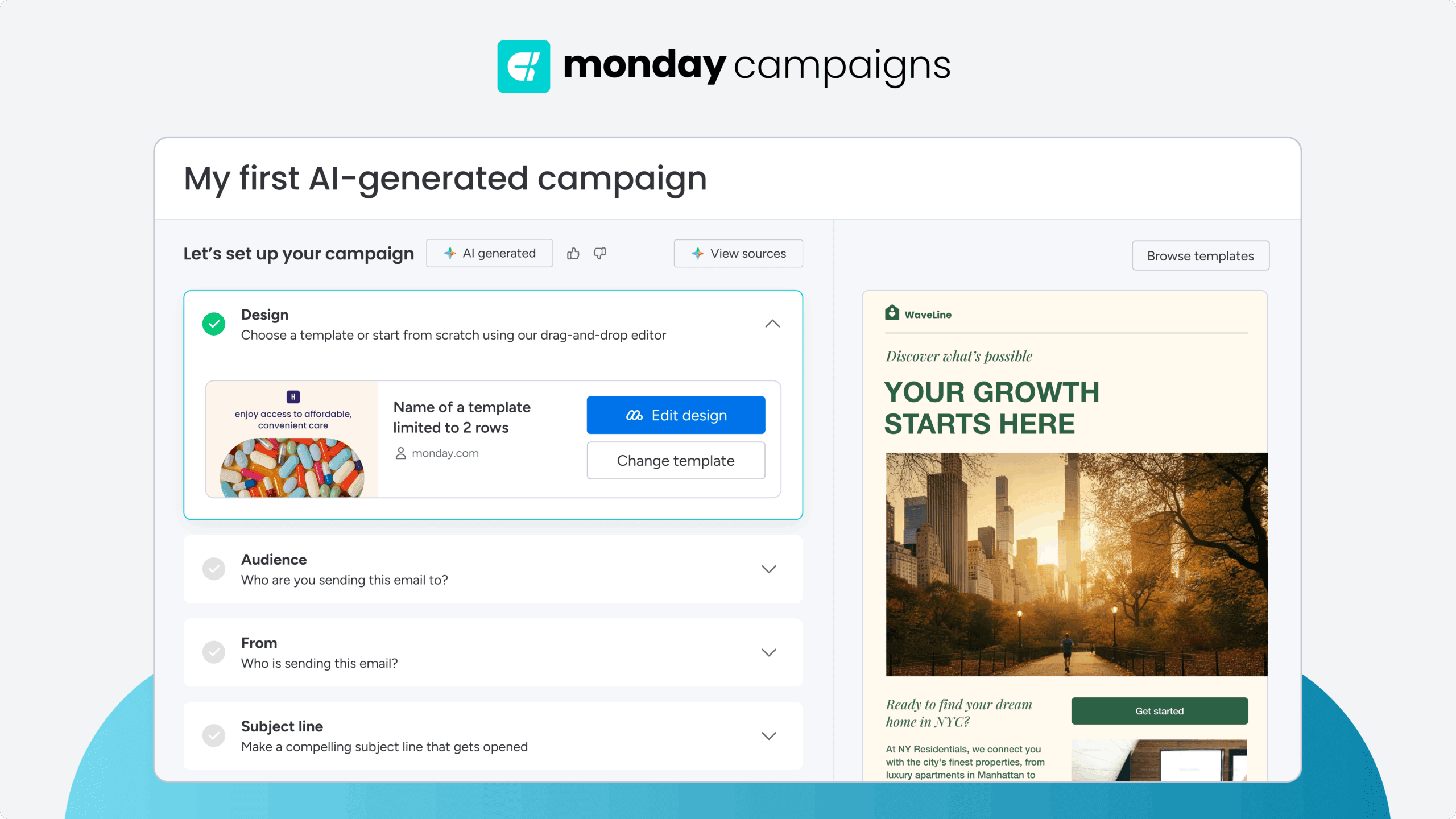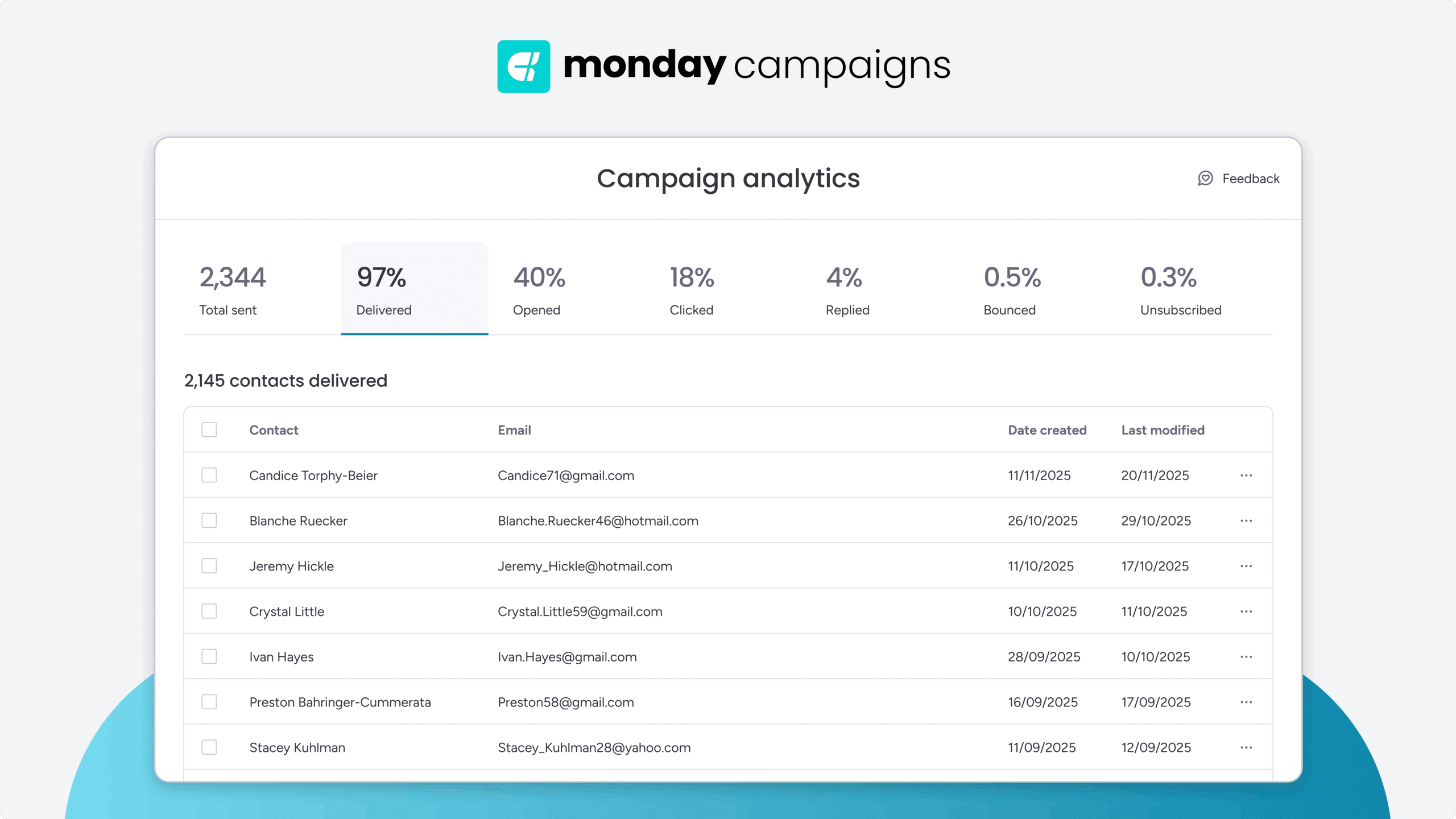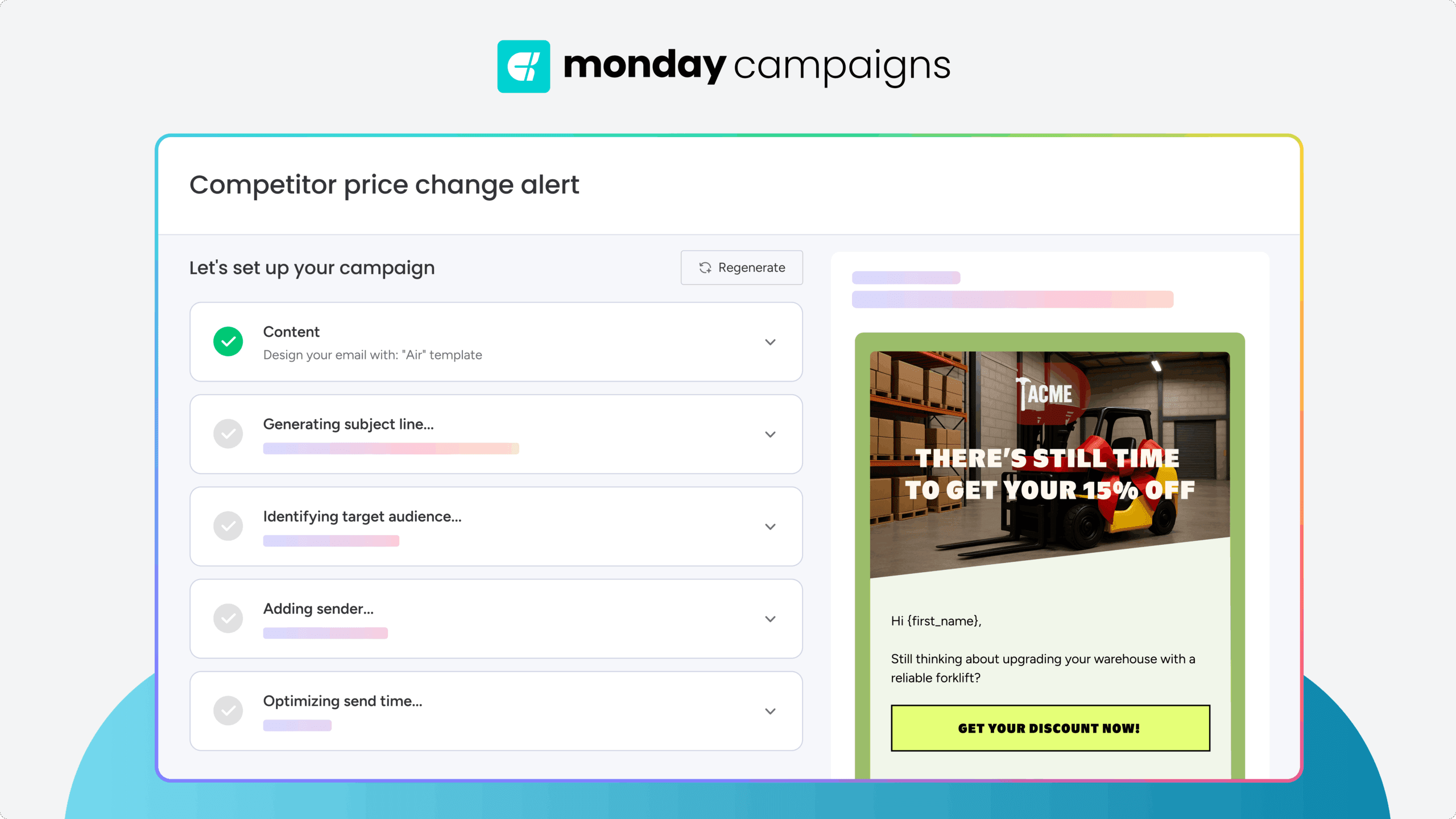Most teams run campaigns across email, social media, and more. But using many channels doesn’t guarantee a cohesive customer experience. When channels operate independently, customers get mixed messages — and your budget goes toward disconnected efforts that don’t add up.
Cross-channel marketing changes that. It links your channels and data so every touchpoint works together, creating a smooth journey from first impression to purchase.
This guide covers the key benefits, challenges, and steps for building a successful strategy. You’ll also learn how AI-powered tools bring your data together and connect marketing activity directly to revenue.
Try monday campaignsKey takeaways
- Cross-channel marketing connects your channels to share data and create unified customer experiences, driving higher revenue than isolated campaigns.
- Customers who engage across multiple channels spend more and stay loyal longer. Focus on creating smooth handoffs between email, social media, and your website.
- Begin with unified customer data and clear segments before building automated workflows that respond across channels. Clean data is essential for effective coordination.
- Measure success through customer journey analytics and multi-touch attribution, not just individual channel performance. Track how channels work together to drive conversions.
- Smart software like monday campaigns uses AI to automatically optimize your cross-channel campaigns and connects directly to your CRM for complete visibility from lead to customer.
What is cross-channel marketing?
Cross-channel marketing is when your marketing channels work together and share data to create one connected customer experience. This means your email campaigns, social media, website, and other channels communicate with each other — so customers get consistent messages that build on their previous interactions.
Think of it this way: when someone abandons their shopping cart, they might get an email reminder, see a social media ad for that same product, and find personalized recommendations when they return to your website. Each touchpoint knows about the others and works together to guide that person toward a purchase.
Cross-channel vs. multichannel vs. omnichannel marketing
Understanding the differences between these approaches helps you choose the right strategy for your business. While they might sound similar, each represents a different level of channel integration and customer experience sophistication.
| Multichannel marketing | Cross-channel marketing | Omnichannel marketing | |
|---|---|---|---|
| Data sharing | Each channel uses its own data, so activity on one doesn’t influence another. | Channels share customer data, allowing actions in one channel to shape responses in others. | All touchpoints update a single customer profile that stays consistent everywhere. |
| Channel coordination | Channels run separately with individual goals and metrics. | Channels coordinate timing and messaging to support each other. | Every channel adapts in real time based on the customer’s latest interaction. |
| Customer experience | Customers often see inconsistent or repetitive messages. | Customers move between channels without repeating themselves. | Customers get a seamless experience across devices and channels. |
How cross-channel marketing drives revenue growth
Cross-channel marketing increases revenue because customers who engage across multiple channels stay loyal longer and have higher lifetime value than single-channel customers. When your channels work together, you create more opportunities to connect with customers at the right moment with the right message.
Revenue grows when you stop wasting budget on disconnected campaigns. Instead of hoping customers see your message, you guide them through a coordinated journey that makes sense. You can amplify this impact with monday campaigns, which connects your marketing data directly to sales outcomes so you can see exactly which channel combinations drive the most valuable customers.
Try monday campaigns5 key benefits of cross-channel marketing
Cross-channel marketing delivers measurable improvements to your marketing performance. These benefits directly impact your bottom line and team productivity, simplifying marketing management processes.
1. More unified customer experiences
Customers expect you to remember their interactions across every touchpoint. The Merchants Martech/CMO Council Omnichannel Survey found that 87% of consumers report frustration when they have to repeat themselves across channels — a clear signal that cross-channel consistency matters.
Cross-channel marketing delivers this by sharing data between touchpoints.
- Recognition across platforms: They don’t have to repeat information or start over.
- Relevant recommendations: Each channel knows their preferences and history.
- Smooth handoffs: Moving from email to website to support feels natural.
2. Higher marketing ROI
You make smarter budget decisions when you see how channels influence each other. Cross-channel marketing reveals which combinations drive the best results.
3. Deeper customer insights
Single-channel data tells only part of the story. Cross-channel data reveals complete customer behavior patterns you’d otherwise miss.
- Journey patterns: How customers typically move between channels.
- Content preferences: What messages resonate across different platforms.
- Timing patterns: When customers engage with different channels.
4. Higher conversion rates
More touchpoints mean more chances to convert — but only when they work together. Cross-channel marketing ensures each interaction builds on the last.
5. Stronger brand consistency
Consistent experiences reinforce credibility. Cross-channel marketing ensures customers encounter the same quality and messaging everywhere.
Cross-channel marketing challenges and solutions
Cross-channel marketing delivers powerful results, but implementation comes with real obstacles. Understanding these challenges — and their practical solutions — helps you build a strategy that actually works instead of one that looks good on paper but fails in execution.
Challenge: Data integration across platforms
Different platforms store data in different formats. This makes creating unified customer profiles difficult without the right systems.
Solution: Choose platforms with built-in CRM integration or using customer data platforms to centralize information. For example, monday campaigns solves this by automatically syncing marketing and sales data, eliminating manual data management.
Challenge: Marketing attribution complexity
The challenge lies in accurately assigning credit when customers engage with multiple channels before converting. Traditional last-click attribution misses the full picture.
Solution: Multi-touch attribution models provide more accurate insights by crediting all channels that influenced the journey. This helps you understand true channel value and optimize accordingly with a data-driven marketing approach.
Challenge: Resource and budget allocation
How do you divide budget between channels when they all work together? This question challenges many marketing teams.
Solution: Start by analyzing historical performance data to see which channel combinations drive results. Then test different allocations and adjust based on actual performance.
Challenge: Technology stack management
Managing multiple marketing platforms creates complexity. Disconnected systems lead to inefficiency and missed opportunities.
Solution: Choose platforms that integrate naturally or invest in solutions that unify your marketing stack. The goal is seamless data flow without constant manual work.
Cross-channel marketing examples that drive results
Real examples show how cross-channel coordination creates business impact. These approaches work across industries with proper adaptation.
- E-commerce: Cart abandonment recovery is a prime example of cross-channel coordination. Email reminders, retargeting, and cross-selling tactics bring customers back. Each channel reinforces the message without seeming repetitive.
- B2B companies: Use B2B marketing strategies for cross-channel nurturing in complex sales cycles. Content downloads trigger email sequences that coordinate with sales outreach. Social proof and retargeting maintain engagement between direct touches.
- Retail businesses: Blend online and offline experiences through cross-channel campaigns. Email offers drive store visits while in-store purchases trigger online follow-up. Mobile apps bridge physical and digital experiences.
- Service businesses: Build trust through coordinated content and communication. Blog posts support email campaigns while social proof reinforces expertise. Each channel contributes to relationship marketing.
7 steps to build a cross-channel marketing strategy
Building an effective cross-channel strategy requires methodical planning. These marketing strategies guide you toward a strong foundation for success.
Step 1: Audit your current marketing channels
Start by understanding what you have. List every channel you use and evaluate its current performance and integration capabilities.
- Performance metrics: What results does each channel currently deliver?
- Data collection: What customer information can you gather?
- Integration readiness: Can this channel connect with others?
Step 2: Unify customer data across platforms
Create a single source of truth for customer information. This means connecting your platforms so data flows automatically between them.
Focus on establishing consistent customer identifiers and cleaning your customer data. Clean, connected data is the foundation for effective coordination.
Step 3: Create strategic customer segments
Use your unified data to build meaningful segments. These groups should reflect real differences in behavior and preferences across channels.
Effective segments are actionable everywhere. If you can’t use a segment across channels, it won’t support cross-channel coordination.
Step 4: Map the cross-channel customer journey
Understand how customers actually move between your channels. This mapping reveals coordination opportunities and friction points.
Look for common paths and decision points. Where do customers typically start? How do they move between channels? Where do they get stuck?
Step 5: Select your optimal channel mix
Not every channel belongs in your strategy. Choose channels that complement each other and match your audience preferences.
Consider where your audience spends time and which channels naturally work together. Quality beats quantity in channel selection.
Step 6: Design connected campaign workflows
Create campaigns with built-in handoffs between channels. These workflows should respond to customer behavior automatically.
For example, email subscribers who click but don’t buy might trigger social retargeting. Website visitors who download content might enter an email nurture sequence.
Step 7: Implement cross-channel reporting
Build measurement systems that show both individual channel performance and cross-channel interactions. You need to see the complete picture.
Your reporting should reveal which channels assist others and how different combinations perform. This insight drives continuous improvement.
Essential channels for cross-channel campaigns
Certain channels form the backbone of effective cross-channel strategies. The key isn’t using every channel — it’s coordinating the ones your customers already interact with.
Email marketing campaigns
Email is often the anchor channel because it provides identity, intent signals, and measurable engagement. It also triggers coordinated actions across other platforms. Some examples:
- Email click → SMS reminder if they don’t complete the action within 24 hours
- Email browse abandonment → social retargeting with the same product
- Email webinar signup → in-app prompt the day before the event
Social media marketing
Social builds awareness and recaptures interest created by other channels. It works best when connected to behavior happening elsewhere. Here are a few ideas:
- Social ad click → content download → leads to an email nurture flow
- Paid social retargeting → personalized website banner when they return
- Instagram engagement → triggers email with matching content
Paid advertising channels
Paid media works in tandem with email, web, and CRM data to reinforce interest at key moments. For example:
- Website product view → Google display retargeting
- Email open → Facebook retargeting to continue the journey
- Pricing page visit → LinkedIn ad sequence for comparison content
Content marketing integration
Content fuels touchpoints across every channel — but in cross-channel marketing, content behavior informs what happens next. Check these ideas out:
- Whitepaper download → enters email workflow
- Reads blog article → triggers YouTube video recommendation via retargeting
- Video completion → website personalization on next visit
Mobile marketing
Mobile adds immediacy to a coordinated journey through SMS, push notifications, and app-based personalization. For example:
- Cart abandonment → email → SMS if unopened
- In-app behavior → triggers email recommendations
- Geolocation → personalized mobile + email offers
Cross-channel marketing metrics and analytics
Measuring cross-channel success requires different thinking than single-channel metrics. You need to understand both individual performance and channel interactions.
Customer journey analytics
Track how customers move between channels to identify successful paths and problem areas. This reveals which channel combinations work best.
Journey analytics show you where customers start, how they progress, and where they convert or drop off. Use these insights to optimize channel coordination.
Channel performance tracking
Measure each channel’s direct impact while understanding its supporting role. Some channels excel at awareness while others drive conversions.
Look beyond last-click attribution to see how channels assist each other. A channel with few direct conversions might be crucial for starting customer journeys.
Revenue attribution models
Choose attribution models that reflect how your channels actually work together. Multi-touch attribution usually provides the most accurate picture.
Different models serve different purposes. Use several models to understand channel value from multiple perspectives.
Campaign ROI measurement
Calculate returns across your entire channel mix, not just individual channels. Consider customer lifetime value to capture long-term impact.
ROI measurement should account for how channels support each other. A channel might seem expensive alone but prove valuable when you see its contribution to the whole.
4 cross-channel marketing automation strategies
Automation makes cross-channel marketing scalable. These strategies help you coordinate without overwhelming your team.
1. Automated campaign workflows
Build triggered campaigns that respond across channels based on customer behavior. When someone takes an action, your channels respond in coordination.
For example, cart abandonment might trigger an email, followed by social retargeting if the email doesn’t convert. This form of marketing automation ensures each step builds on the previous one.
2. AI-powered personalization
Let AI analyze cross-channel data to personalize experiences at scale. Machine learning identifies patterns humans might miss.
Using AI, monday campaigns suggests optimal content and timing based on cross-channel behavior, creating more relevant experiences without manual analysis.

3. Real-time campaign optimization
Automation adjusts campaigns based on performance data. Budget shifts to high-performing channels while underperformers get paused or adjusted.
Real-time optimization keeps campaigns effective as conditions change. You don’t wait for monthly reviews to improve performance.
4. Integrated reporting dashboards
Automated dashboards provide instant visibility into cross-channel performance. Teams see current data without building reports manually.
These dashboards reveal trends and opportunities quickly. You can act on insights immediately instead of waiting for analysis.

How monday campaigns transforms cross-channel marketing
Fully integrated with monday CRM, monday campaigns addresses cross-channel complexity through purpose-built features that connect CRM marketing to business outcomes. The platform simplifies coordination while maximizing impact.
AI-powered campaign creation and optimization

AI analyzes your data to suggest content, segments, and timing that work across channels. This speeds campaign creation while improving performance.
The AI learns from your results to make increasingly accurate recommendations. Content stays on-brand while adapting to what resonates with different segments.
Native CRM and sales integration
Direct CRM connection means marketing sees the complete customer journey through to revenue. This visibility enables true optimization based on business impact.
Sales and marketing alignment happens naturally when both teams work from the same data. Campaign performance connects directly to pipeline and revenue metrics.

Simplified cross-channel campaign management
One platform manages planning, execution, and measurement across channels, streamlining campaign management tasks. This eliminates the complexity of juggling multiple systems.
Templates and workflows make coordination repeatable. What once required technical expertise now happens through intuitive interfaces.
Cross-channel marketing in 2026: What's changed

The cross-channel landscape has shifted dramatically. What worked 2 years ago won’t cut it in 2026 — and understanding these changes determines whether your strategy succeeds or falls flat.
- AI does the heavy lifting: Machine learning now handles personalization and optimization that once required entire teams. AI analyzes cross-channel behavior patterns in real-time, suggesting content and timing that actually converts.
- Third-party cookies are gone: Cookie deprecation has eliminated traditional tracking methods. Successful cross-channel marketing now depends on first-party data collection and unified customer profiles you own and control.
- Signal loss demands smarter attribution: With less tracking data available, multi-touch attribution has become essential rather than optional. You need platforms that connect the dots between channels without relying on third-party signals.
- Customer expectations have evolved: People now expect brands to remember their preferences across every touchpoint instantly. Disconnected experiences that made customers repeat information are no longer just annoying — they actively drive people to competitors.
Launch your cross-channel marketing success
Cross-channel marketing has become essential for competitive businesses. Customers expect connected experiences, and companies that deliver them see measurable results in revenue and loyalty.
Success starts with unified data and clear segments. Build coordination gradually, adding channels as you prove value, and ensure your marketing teams stay aligned. The right technology platform makes this evolution manageable and successful.
Try monday campaignsFAQs
What tools help build cross-channel marketing workflows?
Tools that connect directly to your CRM work best, because they unify customer data, behavior, and campaign actions. Platforms like monday campaigns, integrated with monday CRM, let you create automated workflows across email, social audiences, and website actions — all from one place.
How does cross-channel differ from omnichannel for small teams?
Omnichannel requires deep integration across every touchpoint, which is often resource-heavy. Cross-channel is a practical step for smaller teams — you coordinate your highest-impact channels (like email + social + website) without needing a full interconnected system immediately.
How long does it take to see ROI from cross-channel marketing?
Most teams see initial improvements within 3–6 months as coordinated workflows reduce drop-off. Larger ROI gains (higher lifetime value, more conversions across journeys) typically appear after 6–12 months.
Do I need advanced AI skills to use cross-channel automation?
No. Tools like monday campaigns use built-in AI to suggest content, timing, and segments. You get smarter personalization and orchestration without needing to manage complex algorithms.
Which channel combinations work best for cross-channel success?
The most effective trio for most teams is:
- Email (primary communication)
- Social ads (retargeting + awareness)
- Website personalization (intent + conversion)
This combination creates a loop of awareness → engagement → conversion that works without requiring dozens of platforms.
How do we stay compliant with privacy regulations across channels?
Use centralized consent settings and ensure every channel respects the same opt-in data. For example, monday campaigns syncs consent data with your CRM so email, retargeting, and personalization all follow the same rules.
 Get started
Get started 

